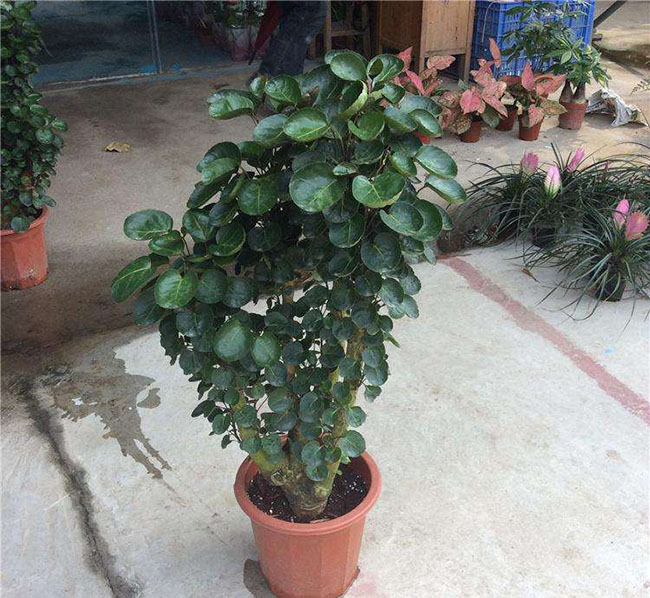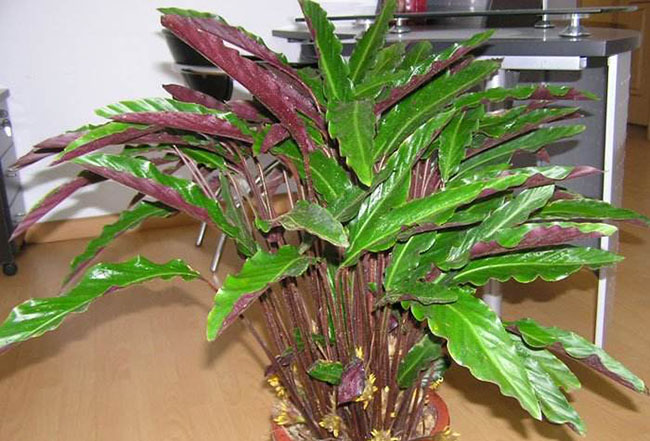Culture methods and matters needing attention of paulownia rotunda
Artemisia angustifolia
Round-leaf Fulutong, also known as round-leaf Nanyangsen, round-leaf Nanyang ginseng, is an evergreen shrub or small tree of Araliaceae and Nanyang forest. The plant is multi-branched and the stem is grayish brown and covered with lenticels. Branches soft, leaves alternate, 3-foliolate pinnately compound or simple, leaflets broadly ovate or suborbicular, base cordate, margin serrulate, leaves green. There are also varieties of flowers and leaves and silver edges.

Morphological characteristics of Alternaria rotundifolia
Round-leaf Fulutong, also known as round-leaf Nanyangsen, round-leaf Nanyang ginseng, is an evergreen shrub or small tree of Araliaceae and Nanyang forest. The plant is multi-branched and the stem is grayish brown and covered with lenticels. Branches soft, leaves alternate, 3-foliolate pinnately compound or simple, leaflets broadly ovate or suborbicular, base cordate, margin serrulate, leaves green. There are also varieties of flowers and leaves and silver edges. In addition, feather leaf Nanyansen, fern leaf Nanyansen, wrinkled leaf Nanyansen, five-leaf Nanyansen, oak leaf Nanyansen and other varieties are also common in cultivation.
Usually less branched, stem surface densely covered with obvious lenticels. Leaves alternate, odd-pinnate, leaflets rounded, stem heart-shaped. Umbels paniculate.
Growth habits of Tripterygium wilfordii
Round leaf Fulutong originated in the Pacific Islands, like warm, humid and sunny environment, resistant to semi-shade, not cold-resistant, afraid of drought. Family farming round-leaf flutong can be placed in a brightly lit room for a long time, as long as you pay attention to avoid direct sunlight in summer. Keep the basin soil moist without stagnant water during the growing period, and often spray the plant with water close to room temperature to increase air humidity and refresh the leaf color. And changing the pot every 2-3 years in spring can make the plant grow more robust. Propagation method of Tripterygium wilfordii
The propagation of D. rotundifolia can cut 1-2-year-old branches for cutting, the cuttings are about 10 cm long, remove most of the leaves to reduce evaporation, maintain high air humidity under the condition of 20 ℃ to 25 ℃, and take root in 4 to 6 weeks. Can also go to the flower market to buy woody stems for cutting, but also easy to survive. The stem is straight and straight, the leaves are bright and changeable, it is a foliage plant. It can be used to decorate living room, bedroom, study, balcony and other places. It is not only fashionable and elegant, but also natural and fresh.
Culture method of round-leaf paulownia
1. Soil:
It is best to choose loose, fertile and well-drained sandy loam for breeding Fulutong. Pot soil can be mixed with 4 parts of rotten leaf soil, 4 parts of garden soil, 2 parts of sand and a small amount of retted cake fertilizer or bone powder.
2. Lighting:
It is necessary to put it in a bright place indoors when breeding it, so as to ensure that it has enough light. Lack of light can easily cause long stems and leaves, dim leaf bags and faded markings, while strong light exposure will burn the leaves of round leaves. Therefore, when family potted cultivation, it can be placed in a well-ventilated place near the south entrance, in front of the north or east window in summer, and indoor light in winter.
3. Temperature:
The optimum temperature for growth is 15-30 ℃, and the lowest culture temperature should not be lower than 10 ℃, otherwise the plants will be damaged by freezing. When the temperature is too high, it should be placed in a cool place or shaded, and water should be sprayed around the plant to cool down.
4. Watering:
Round-leaf flutong likes a wetter environment, so it should be given plenty of water when breeding. Watering should be sufficient in the growing period of round leaf flutong, but in the right amount, do not cause stagnant water, so as to avoid rotten roots. High temperature in midsummer, in addition to more watering, but also need to spray water to the leaf once a day, increase or decrease air humidity. When the temperature is below 15 ℃, watering should be controlled or sprinkled instead of watering, and the basin soil should be slightly moist and slightly dry. When spraying foliage, pay attention to the water temperature close to room temperature.
5. Fertilization:
Family potted plants can apply special fertilizer or mature thin liquid fertilizer every 2 weeks or so. if it is a variety of flowers and leaves, pay attention to the content of nitrogen fertilizer in the fertilizer solution should not be too high, so as to avoid the pattern on the leaf surface to decline or even disappear. After the Mid-Autumn Festival, the application of nitrogen fertilizer should be stopped and phosphorus and potassium fertilizer should be applied 1-2 times to increase the cold resistance of the plant and make it survive the winter smoothly. Stop fertilizing after winter so as not to hurt the roots.
6. Diseases and insect pests:
If you do not pay attention to the hazards such as anthrax and shell insects, it is necessary to prevent and cure it in time when raising round-leaf flutung. If a disease occurs, the diseased leaves should be removed and destroyed in time.
Culture skills and points for attention of round-leaf tree how to raise round-leaf tree
The round leaf Fulu paulownia branches are soft, the plant branches are more, and the growing leaves are mostly small leaves, showing a round shape. The leaves of round leaf are oily green and have high ornamental value, so it is good to plant them in the courtyard or indoors.
How to raise Fulutong with round leaves
First, how to raise round-leaf flutong-- Fertilizer is usually applied every two weeks in a pot. Choose a special fertilizer and dilute it as a liquid fertilizer, but don't continue to apply fertilizer after September. Can let the plant branches and leaves can have enough space to grow, smoothly through the winter.
Second, how to raise round-leaf tree trees-- changing pots is suitable for planting in sunny environments in winter and properly watered. Every two years, the round leaf flutong needs to change the basin, the basin soil needs to be moist and add a certain amount of humus, the basin soil can use rotten leaf soil, add peat soil, and add some chicken manure as fertilizer.
Third, how to raise round-leaf tree tree-- watering round-leaf tree tree does not like drought, so it should be watered frequently. At the same time, the soil is moist but there is no stagnant water. It is often possible to spray some water mist around the plant to keep the leaves green and give it a moist growing environment.
Fourth, how to raise round-leaf tree tree-- it can tolerate semi-shade and is suitable for growing effectively outside or indoors illuminated by fluorescent lamps. It is more sensitive to environmental changes, so before it adapts to the environment, it should be watered more to replenish nutrients.
How to raise round-leaf tree how to raise round-leaf tree
Round leaf Fulu Tong alias round leaf Nanyang ginseng, round leaf Fulu Tong stem tall and straight, bright and changeable leaves, is a good foliage plant. How to raise Fulutong with round leaves? Next, let's take a look at the cultivation method of round leaf flutong.
First, how to raise round-leaf flutong
Round leaf Fulutong originated in the Pacific Islands, like warm, humid and sunny environment, resistant to semi-shade, not cold-resistant, afraid of drought. The family can be kept in a brightly lit room for a long time, and it will grow more vigorously if you can see hours of sunshine every day. Pay attention to avoid the direct sunlight outside in summer. During the growing period, keep the basin soil moist without stagnant water, and often spray the plant with water close to room temperature to increase air humidity and make the leaf color fresh.
Second, the culture method of round leaf Fulu tree.
1. Soil: it is best to choose loose, fertile and well-drained sandy loam for breeding. Pot soil can be mixed with 4 parts of rotten leaf soil, 4 parts of garden soil, 2 parts of sand and a small amount of retted cake fertilizer or bone powder.
2. Temperature: the optimum temperature for growth is 15-30 ℃, and the lowest culture temperature should not be lower than 10 ℃, otherwise the plant will suffer frost damage. When the temperature is too high, it should be placed in a cool place or shaded, and water should be sprayed around the plant to cool down.
3. Light: sufficient light is needed for round-leaf alpinia fortunei breeding. Lack of light can easily cause long stems and leaves, dim leaf bags and faded markings, while strong light exposure will burn the leaves of round leaves. Therefore, it is better to have proper shade in summer and indoor light in winter.
4. Watering: round-leaf flutung likes a wetter environment, watering should be adequate during the growing period, but in an appropriate amount, do not cause stagnant water, so as to avoid rotting roots. High temperature in midsummer, in addition to more watering, but also need to spray water to the leaf once a day, increase or decrease air humidity. When the temperature is below 15 ℃, watering should be controlled or sprinkled instead of watering, and the basin soil should be slightly moist and slightly dry.
5. Fertilization: family potted plants can apply special fertilizer or mature thin liquid fertilizer for foliage plants every 2 weeks. if it is a variety of flowers and leaves, pay attention to that the content of nitrogen fertilizer in the fertilizer solution should not be too high, so as to prevent the pattern on the leaf surface from decreasing or even disappearing. After the Mid-Autumn Festival, the application of nitrogen fertilizer should be stopped and phosphorus and potassium fertilizer should be applied 1-2 times to increase the cold resistance of the plant and make it survive the winter smoothly. Stop fertilizing after winter so as not to hurt the roots.
6. prevention and control of diseases and insect pests: round-leaf tree tree is prone to anthracnose, shell insects and other hazards, which should be prevented and controlled in time. If a disease occurs, the diseased leaves should be removed and destroyed in time.
The above is the introduction of the breeding method of Fulutong, the plants of different specifications decorate the living room, bedroom, study, balcony and so on, which is not only fashionable and elegant, but also natural and fresh, so it is a good choice.
- Prev

Culture methods and matters needing attention of red-backed bamboo taro
Red-backed taro growth habits red-backed taro like to grow in a warm, humid, shady environment, not resistant to cold, afraid of drought, avoid strong light exposure. The suitable temperature for growth is 20-30 ℃, and the overwintering temperature is 15 ℃. The soil for culturing red-backed taro should be sandy soil rich in humus and loose and permeable.
- Next

Culture methods and matters needing attention of Cryptomeria fortunei
Introduction of Cunninghamia lanceolata, trees, up to 60 to 70 meters in origin, DBH more than 1 meter, bark gray-brown or dark gray, thick, transversely lobed; large branches spreading or obliquely extended, young crown tower-shaped, old into a flat top, lateral branchlets dense, drooping, nearly pinnate arrangement. Cunninghamia lanceolata is not resistant to cold and avoid drought.
Related
- Fuxing push coffee new agricultural production and marketing class: lack of small-scale processing plants
- Jujube rice field leisure farm deep ploughing Yilan for five years to create a space for organic food and play
- Nongyu Farm-A trial of organic papaya for brave women with advanced technology
- Four points for attention in the prevention and control of diseases and insect pests of edible fungi
- How to add nutrient solution to Edible Fungi
- Is there any good way to control edible fungus mites?
- Open Inoculation Technology of Edible Fungi
- Is there any clever way to use fertilizer for edible fungus in winter?
- What agents are used to kill the pathogens of edible fungi in the mushroom shed?
- Rapid drying of Edible Fungi

